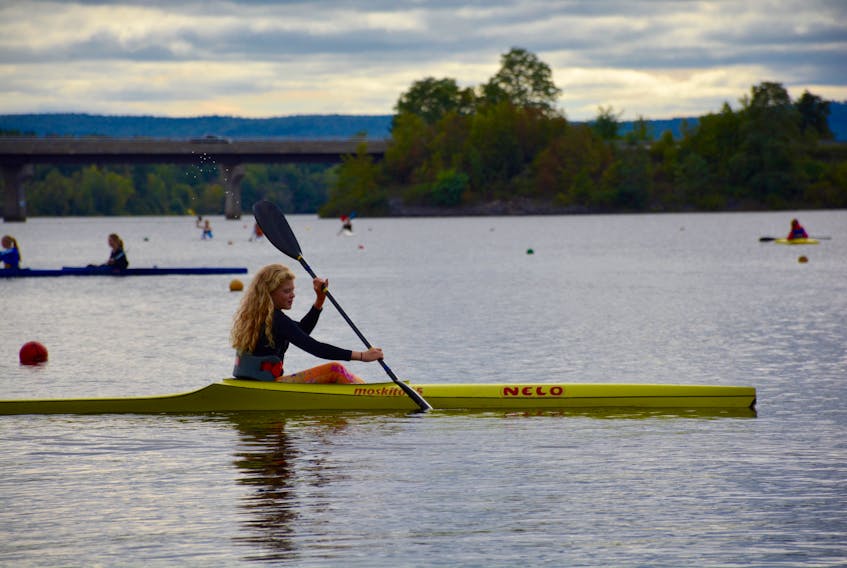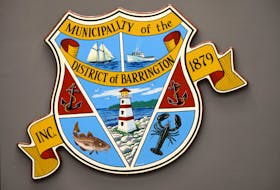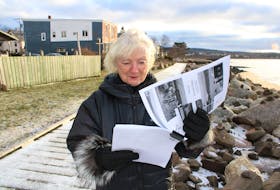WINDSOR, N.S. — After weeks of residents expressing their concerns about the future of Lake Pisiquid, the provincial government and engineering firm CBCL presented a surprise fourth potential option for an updated causeway and aboiteau structure along Highway 101 during the Windsor-West Hants joint council session Sept. 27.
The proposed design, referred to as Option D, would maintain Lake Pisiquid’s water level and keep the water as fresh instead of salty, or brackish. It would also increase the fish passage capacity over the existing system.
Dozens of people were packed in the public gallery at the West Hants council chambers for the meeting and, after representatives from the government finished explaining the new design option, many applauded.
There had been concerns from community members, business groups, politicians and even the fire department, stating that changing the lake’s levels by allowing tidal flow would be a major detriment to the town and surrounding area.
A previous design, referred to as Option C, was considered the most-likely option. It would have allowed restricted tidal flow in and out of the lake, reducing its water levels by two to seven feet and bringing saltwater beyond the causeway.
Preliminary designs for Option D show a new twinned highway roadway structure stretching further north from the existing infrastructure. A new aboiteau would also be built beyond that, with a gap in between.
The existing aboiteau would be left in place to serve as a culvert.
Alexander Wilson, senior water resources engineer with CBCL, presented the new option to both councils.
“We’re in the consultation phase of this project,” Wilson said. “This is a preliminary design, nothing has been decided and (we) are still receiving feedback.”
Option D, referred to as a hybrid design, would offer the following components:
-
The ability to maintain a freshwater lake;
-
The opportunity for improved fish passage;
-
Adaptable design, water management/operation can be adjusted if goals change in the future;
-
Water level control would be much better than current conditions.
The goal would be to keep the status quo in terms of lake levels and salinity while increasing fish passage opportunities.
Wilson said he expects the preliminary design to meet the regulatory requirements.
“Essentially, it would look very similar to the existing structure, with two large openings, with flap gates, four iron doors on chains, behind that vertical lift gates, controlled by computer,” he said. “Any increment (of water level control) can be constantly adapted.”
“A modern design with much more control,” he said. “On the side, we have essentially two types of fishways, the tidal… and the freshwater.”
Wilson emphasized that this option is still in the preliminary stages and could change as consultations continue.
Projected costs for the Option D design aren’t known at this time.

Aging infrastructure will need attention
Kevin Bekkers, manager of land protection with Nova Scotia Agriculture, told the councils that the existing causeway and aboiteau structure, nearing 50 years old, is close to the end of its lifecycle and will likely need to be replaced within the next five years — making now an excellent opportunity to do something about it.
The system is considered vulnerable to storm surges and requires upgrades in order to satisfy safety needs from climate change and corresponding sea-level rise.
The existing causeway and aboiteau protects approximately 1,600 hectares of land in the region.
In a perfect storm scenario, with high tides, a hurricane, and a faulty aboiteau gate, it could lead to severe flooding throughout Windsor’s downtown.
“There is no backup, there’s two gates there and if there’s a malfunction with those gates, we have a potential problem with flooding,” Bekkers said.
The main objective of the new aboiteau project is public safety, he said.
Other components include improved fish passage, which is required through the fisheries act, and minimizing the social and economic impact.
“I’ve sat down with Ski Martock, talked to the CAOs, I’ve sat at picnic tables with farmers, Oulton’s, Bremner’s, Manning’s,” he said.
“Many of the people who make their livelihood here in this community. That hasn’t gone unnoticed, and it’s an important part of this. We’re listening loud and clear,” he continued.
“We’re seeking your feedback, no decisions have been made,” he added. “This is probably the biggest project Windsor is going to face in a long time.”
The aboiteau project is considered a crucial component of the wider Highway 101 twinning, funded in partnership between the province and federal government, that will see continuous twinned highway from Sackville to Hortonville, Kings County.
Peter Hackett, chief engineer with Transportation and Infrastructure Renewal, said it’s estimated to take three to four years to build a new aboutieau structure.
“When we’re all finished, we’re hoping to have a speed limit through here that’s comparable to the rest of the twinned highways across the province,” Hackett said. “We hope to have it all complete by 2022.”
Funding for the aboiteau/causeway component has yet to be announced by the provincial or federal governments.
Paul LaFleche, deputy minister of Transportation and Infrastructure Renewal, asked the public at the end of the presentation what they wanted to see.
“There really are two options here, Option D, and just flying over with bridges and leaving your current structure in place,” LaFleche said.
“It’s a wonderful opportunity to get something new here, but if you want to keep the old one, we’re good,” he continued.
“We’re not ramming a new aboiteau down your throat, we’re giving you one of two options. Unless you tell us tonight that you like Option C, it’s not going to be on the table.”
LaFleche also said the design of Option D shifts the debate over Lake Pisiquid from the construction of the structure to its operation.
“This design allows us to do whatever we would like to do. If you would like to keep the lake, and you’re legally allowed to do it, at 9.285, with enough rainfall, you might be able to keep it there,” he said. “But on the other hand, if someone goes to the judge and says no, no, no, the constitution or charter of rights, there has to be fish passage, then the judge may order (us) to lower the lake or open the gates.”
Fisherman frustrated
Darren Porter, a local fisherman and member of the community liaison committee (CLC) with the twinning project, said he was surprised to hear LaFleche seem to take Option C off the table.
“Option D is a political fix,” Porter said following the presentation.
“Option D goes against everything I heard the First Nations ask for. They asked for tidal flow of some sort. They were willing to entertain Option C to bring some equilibrium back,” he said.
“We just watched the indigenous group’s preferred option, which they were consulted on, completely taken off the table,” he said.
During the meeting LaFleche said consultations with the First Nations is ongoing and that nothing is set in stone yet.
Porter said this design hasn’t been put through enough scrutiny and is skeptical that fish passage levels will be as robust as the government claims.
In an e-mailed statement, TIR minister Lloyd Hines reiterated that the province has not made any concrete decisions on the aboiteau or the causeway at this point.
“It is very important to us to have input from the community ahead of making a decision,” Hines said. “We recognize the value of this lake to the community and are now in the process of consulting with various stakeholder groups and the public on the initial design options in order to obtain their feedback on key issues and areas of concern. This will help refine the options and identify any others that could best meet the needs of the community.”
A public meeting is scheduled for Oct. 10 at the Royal Canadian Legion in Windsor, with members of the Highway Twinning Community Liaison Committee and provincial staff. It’ll be the first chance for a major public meeting on what’s happening at that site.

MLA optimistic compromise can be reached
Prior to the joint council meeting where Option D was presented, Hants West MLA and minister of municipal affairs Chuck Porter said he’s been bringing the concerns of his constituents to his caucus colleagues.
“The town and surrounding communities have certainly developed around that and we will continue to develop around that; things are just getting started,” Porter said. “I’m sure as we move forward… we will come up with a plan that will work for everyone.”
Windsor Mayor Anna Allen largely echoes Porter’s views and said she’s pleased the government is listening to the area’s concerns.
I’m “very pleased that the province listened to the concerns that were well expressed by the community. This lake means a great deal for many people including visitors,” said Allen in an email interview. “Option D seems to meet our requirements and hope that any other interest groups will be satisfied. I am excited to see you what innovative systems are used in securing our lake for the next 75 years.”
Fire back-up at risk
Windsor Fire Department Chief Scott Burgess said he’s very pleased to see the twinning project moving forward.
“We know that twinning reduces fatalities and serious injuries, it’s awesome to see this happen,” Burgess said.
But, he is hopeful that Lake Pisiquid can remain in its current form to ensure a major water reserve for the fire department.
It came in handy during the Edgehill Estates fire in 2016.
“The town’s water system is designed for a certain limit, but because a lot of the old towns — Windsor, Lunenburg, Chester — with massive fire loads in their downtown, have relied on backup water supplies,” he said
During the Edgehill Estates fire, they extracted approximately one million gallons of water out of Lake Pisiquid. Burgess said they’ve used the lake as a backup supply several times in the past.
“It’s seldom used, but when we need it, it’s there,” he said.
Using the lake prevents the WFD from drawing too much water from the Windsor Water Utility, which could trigger a boil water advisory if too much is used.
Burgess said that if Lake Pisiquid was lowered, it would be nearly impossible to pump water from it.
Additionally, he said using saltwater not only damages the pumps, valves and hoses, but also the breathing apparatuses, the radios — essentially anything the water could touch as it’s misted into the air.
He said all of that damage could have a significant economic impact.
“My biggest concern is that if the lake level isn’t maintained, we’ll lose a full-fledged back up water system,” he said. “I’m all for the twinning, we’ve faced enough fatalities and tragedies — it’s going to save lives.”

Life or death for canoe club
Sheldon Hope, vice commodore of the Pisiquid Canoe Club, said their organization would be unable to continue if the lake changes to a tidal flow, which has been proposed as one of the options for a new aboiteau/causeway.
“It would be the end of the club, to be completely plain,” Hope said. “The restricted tidal flow would take the water down between two and six feet below the current level. That would basically mean we have no water in the lake for significant periods of time.”
Hope said he also has concerns that sediment from the other side of the causeway would eventually build up and create a salt marsh.
“That would mean the end of summer recreation programs for about 100 people per year,” he said. “Plus, year-round paddling for a number athletes, with 25 this fall.”
Hope said it would also mean the end of several related jobs, including a full-time coaching position and several part-time positions.
The Pisiquid Canoe Club has been in operation for approximately 43 years.
“I think there are other options out there that need to be explored,” he said. “There would be a huge economic impact, not just on the canoe club, but on the whole area. That waterfront is a valuable thing.”









